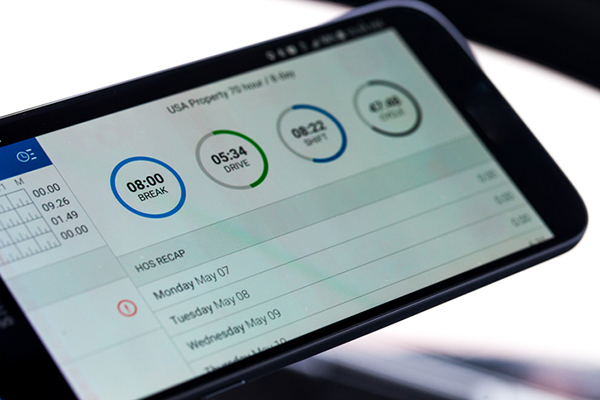New HOS tweaks in effect with flexibility lauded on 30-minute driver rest breaks
The latest tweaks to the 83-year-old truck driver hours of service regulations went into effect Sept. 29 as the Transportation Department’s Federal Motor Carrier Safety Administration (FMCSA) attempts to build in flexibility to a monolithic regulation covering some 3.5 million long-haul truckers.
The trucking industry is giving Transportation Secretary Elaine Chao and the Trump Administration high marks for listening directly to the concerns of truckers seeking rules that are safer and have more flexibility.
“This is a very reasonable approach that will be well received by both drivers and fleets,” Schneider President and CEO Mark Rourke told LM. “It will help productivity. It’s not about forcing drivers to do things they don’t want to do. It’s just a more driver friendly way of managing your body and fatigue.”
Derek Leathers, vice chairman, president and CEO at Werner Enterprises, the nation’s sixth-largest truckload carrier, said he projects productivity improvements of about 1.5% in his operations.
“There are some aspects [of the rule] we like a lot, like the 30-minute flexibility for the driver to be able to walk and accomplish tasks while taking a break,” Leathers said at the CSCMP EDGE virtual conference. “The spirit of it was to get drivers out of the cab and getting the body moving rather than making them stand there and stare at their watch…so there is some flexibility there that makes a lot of sense, I think. In total, it does provide some more flexibility.”
After literally thousands of public comments, listening sessions with drivers and others around the country, the FMCSA issued a final rule in late spring. That rule went into effect Sept. 29.
These updated HOS rules are based in part on 2,800 public comments that offer revisions and flexibility in four key rules:
- building flexibility for the 30-minute break rule by requiring a break after eight hours of consecutive driving and allowing the break to be satisfied by a driver using on-duty, not driving status, rather than off-duty status;
- modifying the sleeper-berth exception to allow drivers to split their required 10 hours off duty into two periods: an 8/2 split, or a 7/3 split—with neither period counting against the driver’s 14‑hour driving window;
- modifying the adverse driving conditions exception by extending by two hours the maximum window during which driving is permitted; and
- changing the short-haul exception available to certain commercial drivers by lengthening the drivers’ maximum on‑duty period from 12 to 14 hours and extending the distance limit within which the driver may operate from 100 air miles to 150 air miles
FMCSA estimated these modernized HOS regulations would save nearly $274 million annually for the U.S. economy and American consumers, although it is not entirely clear how it arrived at that figure. The trucking industry employs 7 million people and moves 70 percent of the nation’s domestic freight by value and has proven to be a key resource in helping keep the nation’s supply chains open during the COVID-19 pandemic.
Despite significant contractions in freight demand this year, a new American Trucking Associations forecast makes clear that the long-term trend for trucking is positive.
Total freight volumes in 2020 are likely to collapse by 10.6% to 14.6 billion tons, although truck freight volumes could fall a smaller 8.8%. But next year trucking volumes are expected to rebound, rising 4.9% by 2021 and then estimated to grow 3.2% per year on average through 2026.
Overall freight revenues in 2020 will total $879 billion, rising to $1.435 trillion in 2031, according to ATA projections.
To help supply that anticipated freight demand, during the Trump Administration the FMCSA has prided itself on focusing and hearing directly from commercial drivers and incorporating their opinions and concerns into its safety initiatives. FMCSA continues to hold listening sessions and discussions with the motor carrier industry to gather feedback and shape FMCSA’s priorities.
It recently launched a new panel to its Motor Carrier Safety Advisory Committee (MCSAC) to be comprised of commercial motor vehicle (CMV) drivers. This new panel will provide direct feedback to FMCSA on important issues facing the driving community—safety, hours-of-service regulations, training, parking, and driver experience, among others.
Transportation Secretary Elaine L. Chao has called truck drivers and other CMV operators “American heroes” who stepped up their game during the COVID-19 health emergency to keep the economy moving. She has said that drivers’ input into rules is “essential” to safety on the highways.
A new panel of 20 to 25 drivers from all sectors of the CMV industry—tractor trailer drivers, straight truck drivers, bus drivers, hazardous materials drivers, agriculture haulers, and others will be included in the new MCSAC. FMCSA’s goal with the new driver panel is to capture the “wide array of viewpoints and experiences within the CMV community,” the agency said.
“The Department of Transportation and this Administration believe in listening to our drivers and hearing their concerns directly,” FMCSA Deputy Administrator Wiley Deck said in a statement. “We know that many of the solutions to the challenges we face don’t come from Washington—they come from the hard-working men and women who are behind the wheel all over our nation. This new subcommittee to MCSAC will further help us hear from America’s commercial drivers.”
The complete HOS final rule is available here.













